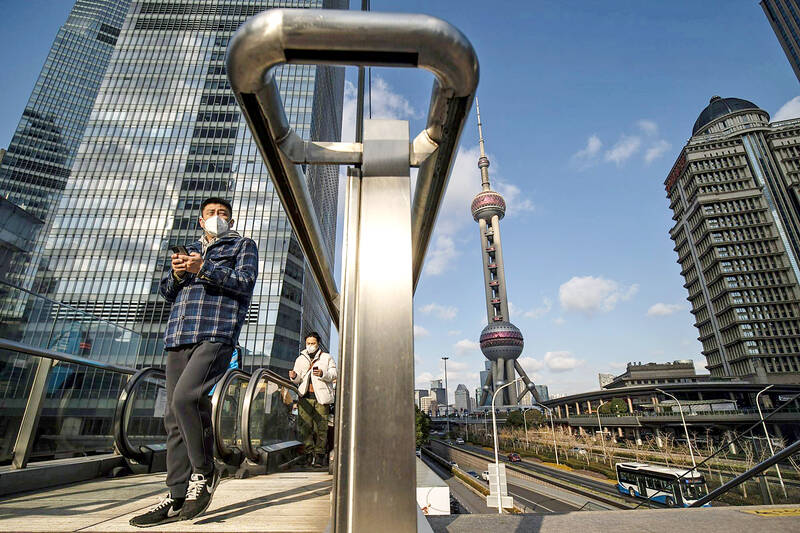China’s economy ended the year in a major slump as business and consumer spending plunged last month, with more disruption likely in the first few months of the year as COVID-19 cases surge across the country.
Official data over the weekend showed that the decline in manufacturing worsened last month, while activity in the services sector plunged the most since February 2020.
Separately, a private survey of businesses by China Beige Book International on Monday said the economy likely posted an annual contraction in the fourth quarter of last year.

Photo: Bloomberg
China’s ditching of strict COVID-19 controls last month fueled a surge in infections in major cities, prompting people to stay home as they fell ill or feared becoming infected.
While the outbreak has likely peaked in places such as Beijing, and economic activity is starting to rebound there, the virus is spreading fast across the country. A likely travel rush during the Lunar New Year holiday later this month could see cases spread to rural areas, disrupting activity in the first quarter of this year.
A private purchasing managers’ index survey yesterday confirmed the worsening decline last month.
The Caixin manufacturing index — which covers mainly smaller, export-oriented businesses — dropped to 49 from 49.4 in November.
However, businesses were optimistic about the future, with confidence in the 12-month outlook climbing to a 10-month high.
“China’s growth prospects have been improving with the reopening accelerating,” said Zhou Hao (周浩), chief economist at Guotai Junan International Holdings Co (國泰君安國際控股). “Overall, the darkest hour is gone.”
Economists expect a faster rebound once the infection wave peaks, with growth forecast to accelerate to 4.8 percent this year from an estimated 3 percent last year.
Still, the recovery is likely to be bumpy, and economic activity remains well below pre-COVID-19 levels.
Travel was relatively muted over the three-day New Year holiday.
The number of trips made was little changed from a year earlier, while tourism revenue was up 4 percent from the same period last year, the Chinese Ministry of Culture and Tourism said.
Tourism revenue was just 35.1 percent of the levels reached in 2019, while the number of trips were 42.8 percent.
China Beige Book, a provider of independent data, said its surveys found that the economy likely grew only 2 percent last year.
“With the ongoing COVID tidal wave, investment sliding to a 10-quarter low and new orders continuing to get battered, a meaningful first-quarter recovery is increasingly unrealistic,” China Beige Book chief economist Derek Scissors said.
Policymakers have pledged more fiscal and monetary support to aid the economy’s recovery this year. The Ministry of Finance last week said that fiscal spending would be expanded “appropriately” with the use of policy tools such as the budget deficit.
The central bank also vowed to support domestic demand and maintain credit growth.
China is likely to cut interest rates and the reserve requirement ratio for banks in the first half of the year, while raising the fiscal deficit ratio for this year, a survey of economists published yesterday in state media found.

Taiwan Semiconductor Manufacturing Co (TSMC, 台積電) last week recorded an increase in the number of shareholders to the highest in almost eight months, despite its share price falling 3.38 percent from the previous week, Taiwan Stock Exchange data released on Saturday showed. As of Friday, TSMC had 1.88 million shareholders, the most since the week of April 25 and an increase of 31,870 from the previous week, the data showed. The number of shareholders jumped despite a drop of NT$50 (US$1.59), or 3.38 percent, in TSMC’s share price from a week earlier to NT$1,430, as investors took profits from their earlier gains

In a high-security Shenzhen laboratory, Chinese scientists have built what Washington has spent years trying to prevent: a prototype of a machine capable of producing the cutting-edge semiconductor chips that power artificial intelligence (AI), smartphones and weapons central to Western military dominance, Reuters has learned. Completed early this year and undergoing testing, the prototype fills nearly an entire factory floor. It was built by a team of former engineers from Dutch semiconductor giant ASML who reverse-engineered the company’s extreme ultraviolet lithography (EUV) machines, according to two people with knowledge of the project. EUV machines sit at the heart of a technological Cold

Taiwan’s long-term economic competitiveness will hinge not only on national champions like Taiwan Semiconductor Manufacturing Co. (TSMC, 台積電) but also on the widespread adoption of artificial intelligence (AI) and other emerging technologies, a US-based scholar has said. At a lecture in Taipei on Tuesday, Jeffrey Ding, assistant professor of political science at the George Washington University and author of "Technology and the Rise of Great Powers," argued that historical experience shows that general-purpose technologies (GPTs) — such as electricity, computers and now AI — shape long-term economic advantages through their diffusion across the broader economy. "What really matters is not who pioneers

TAIWAN VALUE CHAIN: Foxtron is to fully own Luxgen following the transaction and it plans to launch a new electric model, the Foxtron Bria, in Taiwan next year Yulon Motor Co (裕隆汽車) yesterday said that its board of directors approved the disposal of its electric vehicle (EV) unit, Luxgen Motor Co (納智捷汽車), to Foxtron Vehicle Technologies Co (鴻華先進) for NT$787.6 million (US$24.98 million). Foxtron, a half-half joint venture between Yulon affiliate Hua-Chuang Automobile Information Technical Center Co (華創車電) and Hon Hai Precision Industry Co (鴻海精密), expects to wrap up the deal in the first quarter of next year. Foxtron would fully own Luxgen following the transaction, including five car distributing companies, outlets and all employees. The deal is subject to the approval of the Fair Trade Commission, Foxtron said. “Foxtron will be